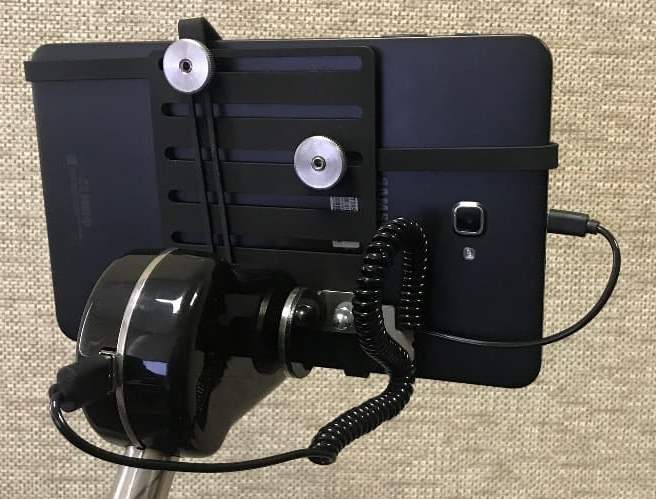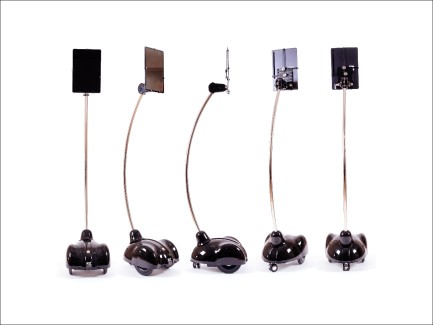The vast majority of the robots use WebRTC technology developed by Google and standardized by the W3C consortium. This technology already has built-in video compression algorithms with VP8 and H.264 codecs, camera access methods, algorithms for adjusting video resolution to the bandwidth of the communication channel, as well as algorithms for obtaining the IP addresses of the robot and the client. The video quality is determined by the bandwidth of the channel from the robot's video camera to the remote user's monitor screen. It is possible to reduce the resolution of the video programmatically, but it cannot be increased. The bandwidth of the entire video transmission channel is determined by the slowest its part. There are three such parts: Internet, processor in the robot head, and processor in the user's gadget that controls the robot.
As usual, Internet is the narrowest link in the communication channel, especially if the robot is at an exhibition where many consumers are connected to the same WiFi access point. In conditions when a powerful desktop computer is used on the client-side and the Internet has a large bandwidth, the video quality is determined by the processor performance in the robot. If the client uses an old low-power smartphone, then the video quality depends on the performance of its processor.
Since robot manufacturers try to use the most powerful processors available on the market at the time of the robot's creation, the video quality of all robots turns out to be approximately the same if they are made at the same time and use processors comparable in performance. The exception is cases when not universal processors are used in the work, but specialized ones for video processing.
As new processors become available, they are most quickly introduced into smartphones and tablets due to the huge size of this market. The market of specialized processor modules (printed circuit boards) is more inert for natural reasons associated with the small production volume of such products. Therefore, robots that have the ability to replace the tablet installed in the robot's head allow you to get better video at any time by simply replacing an outdated tablet model with a more modern one.
Many telepresence robots are available with already built-in touch screens and with integrated processor boards (for example, Double 3 and Ohmni), others use ready-made tablets inserted into the robot's head (for example, Double 2, BotEyes, Padbot U1).
The built-in touch screen with a built-in processor module, unlike a ready-made tablet, has a number of advantages: it allows you to connect any webcam, for example, a rotary camera with magnification (pan-tilt-zoom) or several cameras, non-standard microphones (microphone array), collision sensors. Theoretically, they can also be connected to a standard tablet via a USB-OTG cable, but this technology is not supported by all tablets and not all operating systems.
The disadvantage of robots with integrated processor modules and touchscreens is that the semiconductor element base used in them becomes obsolete very quickly. At the same time, when working with a removable tablet, it can always be replaced with a more powerful, latest modification, and even with an updated OS.
A robot with a removable tablet has another advantage that is not obvious at first glance: it can be positioned both horizontally and vertically. What does it give? The fact is that the matrix of the video sensor in the camera has a certain aspect ratio, for example, 16:9. If the monitor of your computer that controls the robot has the same aspect ratio, and the camera position and the monitor position are the same (both are located horizontally), then the camera image is displayed entirely on the screen. However, if the tablet in the robot (or, what is the same, the camera) is positioned vertically, and the remote monitor is horizontal, then to the right and left of the video you will see large black stripes occupying most of the screen, and it will look something like this (https://www.youtube.com/watch?v=eXro2yj9JgI):
 This is how the image from the robot looks when the aspect ratio of the camera and monitor is inconsistent
This is how the image from the robot looks when the aspect ratio of the camera and monitor is inconsistent
If we try to stretch the image in width, then part of the image will be cropped vertically. The only correct way out is to coordinate the position of the monitor and the position of the camera in operation. Namely, if you are using a desktop computer with a screen positioned horizontally, then the tablet in the robot head must be positioned horizontally. If you use a smartphone that is convenient to hold vertically, then the tablet in the robot head should be positioned vertically. The ability to change the position of the tablet is available only in the BotEyes robot.
An additional advantage of using a removable tablet is the ability to install any familiar program like Skype or Zoom on it instead of the default application.
The ability to change the tablet also saves the buyer a lot of money, because depending on his requirements, an inexpensive tablet worth $ 300 or an expensive one for $ 1,500 can be put into the robot.
The size of the tablet determines how much detail you can view the remote scene. Usually, 10-inch screens are used in robots. The required size depends on what purpose you are using the robot for. The advantage of robots with a removable tablet is the ability to use any tablet, as for example, from 8 to 12 inches (see the figure below).

Removable tablet in the telepresence robot head
The ideal telepresence robot should be light and tall so that a person does not have to bend down to view the image on the screen. But it is possible to keep the tablet on a high and movable stick only with the help of automatic balancing. Therefore, there is an obvious huge temptation to make a robot on the principle of a segway. However, this desire generates a large number of technical problems described below.
The main problem is that two-wheeled robots fall, and this leads to damage to the tablet, which is often more expensive than the robot itself. This happens when the robot touches one wheel, for example, a sofa or human, and the second continues to go, or when overcoming a doorstep. In these cases, the performance of the balancing system may not be sufficient to compensate for external influences. That is why robots of this type use soft edging around the tablet.
The second problem is lateral stability. When a person rides a segway, he provides lateral stability with the movement of his body. In the case of a robot, it is necessary to make a second auto-balancing system - transverse, along with longitudinal. For this reason, the first two-wheeled robots that do not have transverse balancing could not overcome even a wire lying on the floor without falling. The latest versions of such robots have a transverse balancing system and have become much more stable than the first versions, however, they still fall down when moving even low thresholds, if the wheels do not overcome the threshold simultaneously.
The third problem is that in such robots it is difficult to realize the tilt of the tablet since the tilt sensor that provides balancing the whole robot is located in the tablet itself. In addition, the balancing algorithm itself becomes more complicated. To compensate for the inability to change the viewing direction by tilting the tablet, a fisheye camera is usually used, which allows you to see what is at the bottom of the robot. Unfortunately, such a camera greatly distorts the space and generates operator discomfort.
The fourth problem is that due to the inertia of the entire system and the limited speed reaction of the motors, the robot strongly deviates backward or forwards during the start of the movement and after stopping, which also causes psychological discomfort.
All these disadvantages and problems are compensated by the fact that two-wheeled robots are the lightest on the market, which is very convenient when transporting them.
Opposite properties and problems are typical for three- and four-wheeled robots. They solve the problem of stability much easier: with the help of an increased base area and increased chassis weight. This approach immediately allows you to solve a number of problems of two-wheeled robots: tilting the tablet at any angle, easy inspection of the space around the wheels, no need for a fisheye lens for the camera, the presence of transverse and longitudinal stability at the same time, the ability to overcome fairly high thresholds (BotEyes robot overcomes doorsteps up to 2 cm). The price for this is more weight, higher transportation costs, large dimensions of the base.
In order to avoid obstacles, the robot operator must see them. Telepresence robots use two ways to do this: a second camera that shows the space around the wheels, and the tilt of the camera or tablet.
The disadvantage of the option with the second (navigation) camera is the reduction of the useful area of the screen. The photo below shows how the operator's screen of such a robot looks like:

In bottom of image you can see the image from the navigation camera
There are options when the view of the wheels is superimposed on the view from the main camera. In this case, the area of the main image becomes larger, but still part of it is occupied by the view from the navigation camera, which uses very seldom.
If we use the tablet front camera to inspect the floor, there is no such effect and the useful image occupies the entire area of the screen:

When using a tiltable camera, the main view takes up the entire area of the screen
Using the same camera simultaneously for navigation and the main purpose is justified since obstacles bypassing takes up a small fraction of the total time of using the camera.
The second advantage is that the rear camera of the tablet is not attended for any purpose and can be used to inspect the scene behind the robot by quickly switching cameras. In addition, the rear camera of most tablets has a much higher resolution and this can be used, for example, to read text on a school board.
There is also a useful psychological effect of being able to tilt the tablet: the tilt can be made so that the interlocutors have the feeling that they are looking into each other's eyes. It is very important.
The type of battery affects three characteristics of the robot: safety, battery life and robot stability.
Lithium batteries used in the vast majority of telepresence robots are dangerous for ignition. Despite the vigorous efforts made in recent years in their design and production, despite the presence of protection against overcharging, short circuit, balancing, there are still cases of their explosion and ignition. The list of incidents can be viewed on the website of the US Department of Transportation and they continue to this day. Therefore, the use of impenetrable lead-acid batteries in telepresence robots is preferable from the point of view of safety.
It also follows from the safety documents that the higher the capacity of a lithium battery, the more energy is released when it ignites and the more severe the consequences. Therefore, only batteries with a capacity of fewer than 100 watts per hour are allowed to be transported by air. We think that this circumstance limits the duration of operation of many telepresence robots to five hours. In contrast, robots with lead-acid batteries are safe, so there are no restrictions on their capacity during transportation and any capacity batteries can be installed in the robot.
The large weight of lead-acid batteries placed in the lower part of the chassis also ensures the good stability of the robot.


